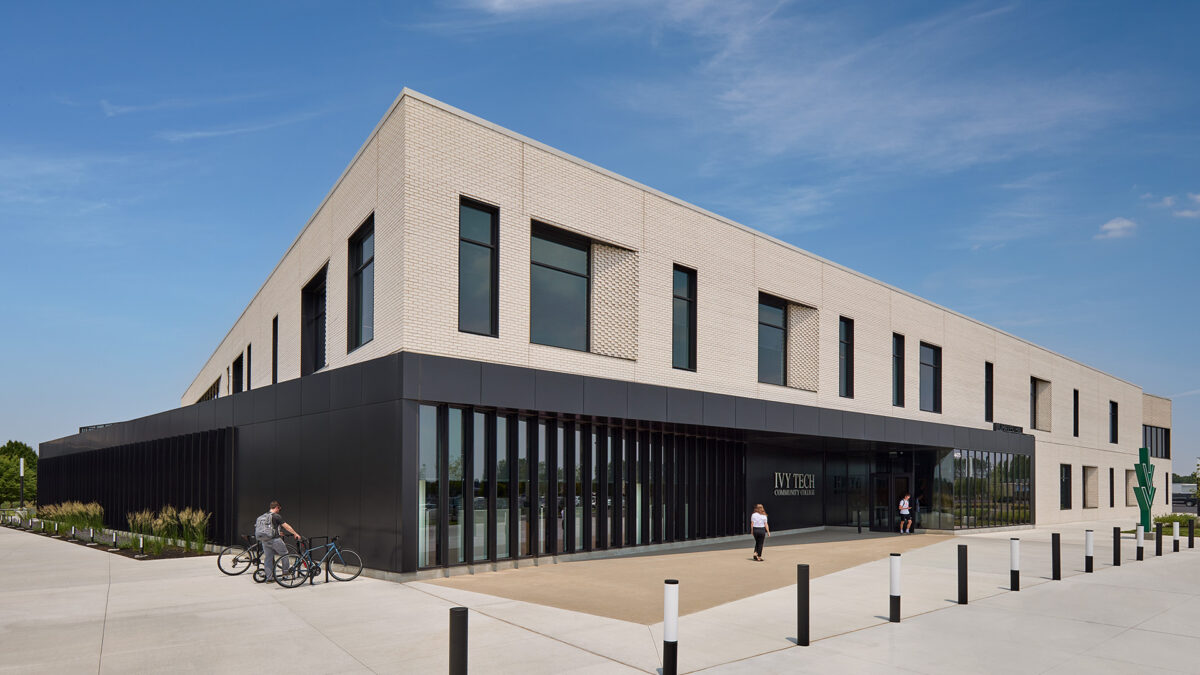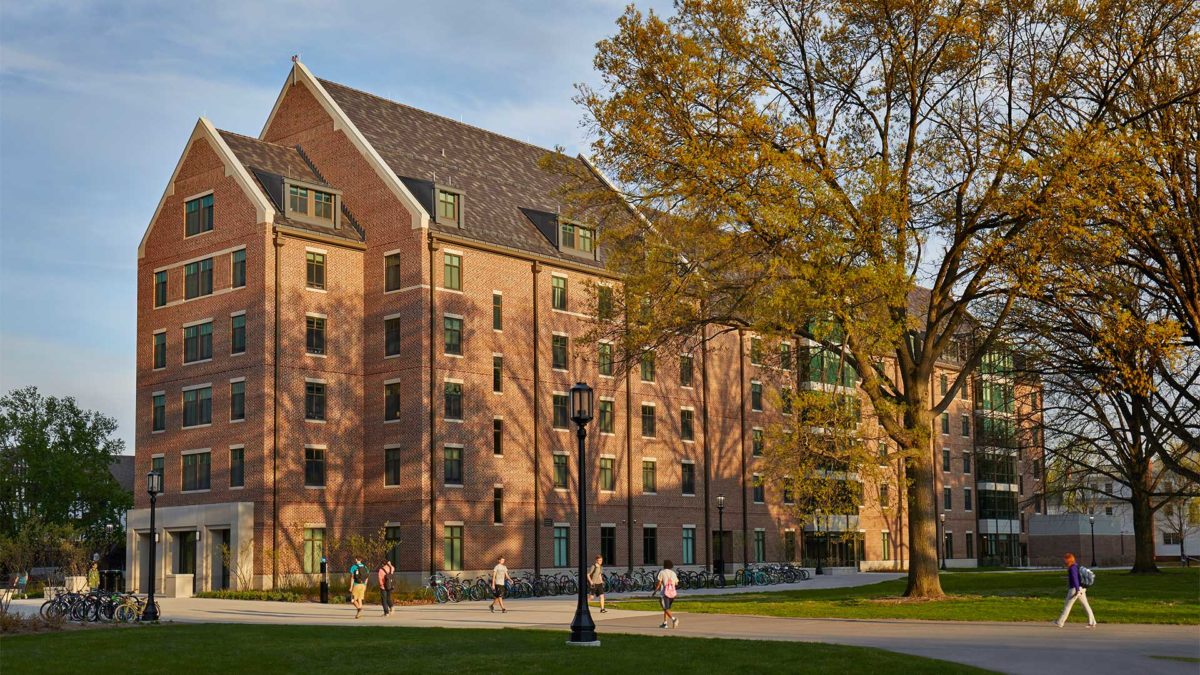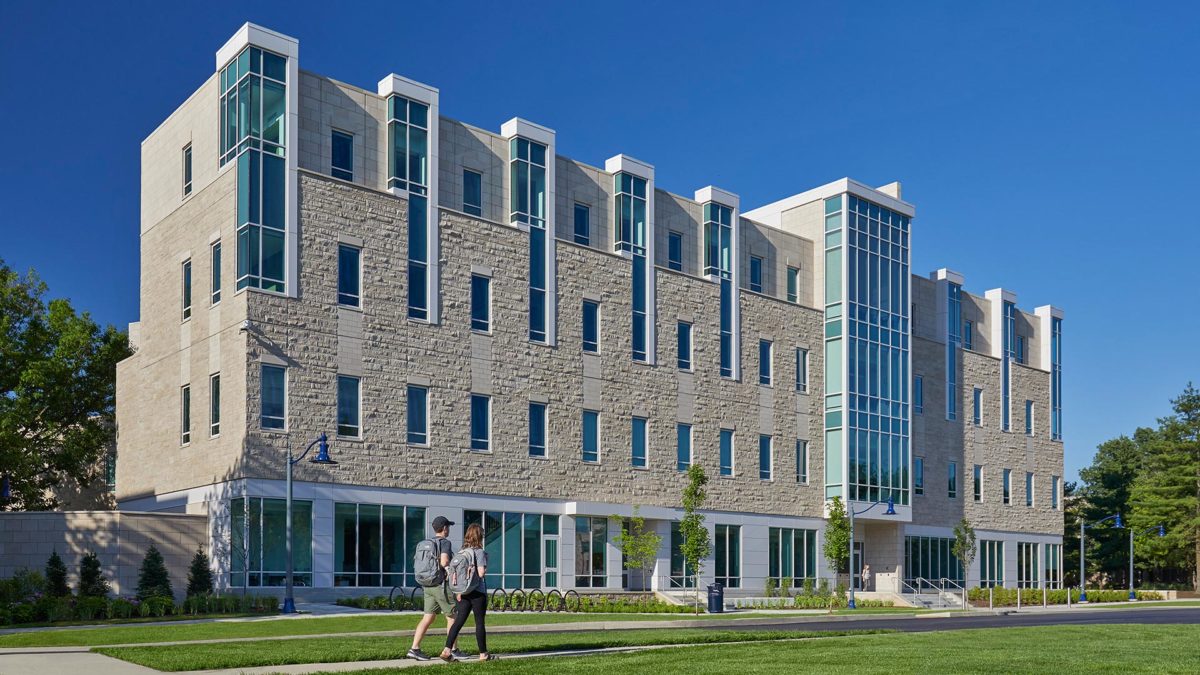
The design features innovative spaces for experiential learning, including: flexible classrooms where local professionals teach workplace-style classes, centers staffed by organizations that involve students in research and outreach, and collaborative workspaces where students develop their own business in concert with experts from the region. The building represents Butler’s competitive distinction from its peer institutions by making activities and interaction immediately visible and central to students’ experience. The design provides visibility by creating transparent spaces that invite participation in central locations around the multi-story atrium at the heart of the building. In addition, the central, broad, open stairs and generous balconies encourage creative collisions as students, faculty, and visitors move and interact throughout the building.
The Innovation Commons, which opens onto the central atrium, is equipped for students to start and run their own businesses as well as a wide range of other types of experiential learning. The Centers, distributed around the main level, provide space where business professionals, faculty, and students work together to solve business challenges. Glass overhead doors open to connect to the atrium and convey the importance and vitality of that work to the school and its guests.
The Butler Business School is named in honor of Andre B. Lacy, a local, successful entrepreneur and philanthropist, as well as a committed family man and daring adventurer. CSO’s interior design studio honored his life with a series of installations that incorporate a collection of custom-designed icons representing his many facets. The icons appear throughout the building as design elements in areas such as the rug in the main atrium and small medallions that are hidden throughout the building. A timeline of his life takes the form of 25 envelopes, connecting his first job in a mailroom and the endowment gift, reminding students that their humble beginnings can build to something great. The design team also featured objects that were important to Lacy – the time clock Lacy once used to clock into his job and the motorcycle he rode across continents. These were both gifts from the family who were intimate collaborators on the project. The conference table in the board room adjacent to the Dean’s office features the Lacy family knot and is a duplication of a table that exists at Lacy’s corporate headquarters.
Located in a prominent place on the campus, visible from the east entrance, the building completes the cross axis of the original campus masterplan. The building’s vertical towers and active silhouette reflect the characteristics of the much-loved historic campus. The building replaces a parking lot and defines the intersection of the two major green spaces at the center of the campus. CSO completed this project in collaboration with Goody Clancy.
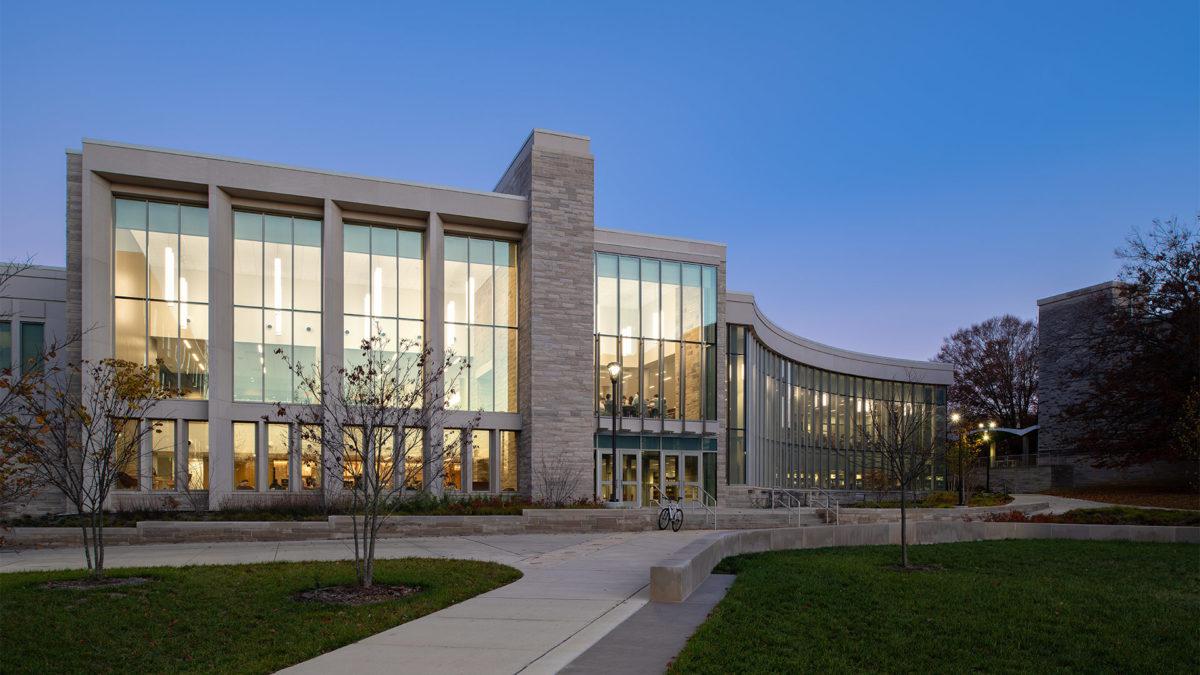
The McNutt Dining Project includes a renovation and addition to the existing McNutt Center building in the McNutt Quadrangle Residence Hall Complex. In addition to a larger dining facility and main kitchen, the project includes Residence Life offices and other associated support spaces. The renovation and addition is isolated to the ground and first floors of the existing building. The upper two floors primarily remain as is, except for miscellaneous mechanical spaces and chases.
The architectural expression of the new building addition is sympathetic to the existing Mid-Century Modern architecture of McNutt Quadrangle. Indiana ashlar limestone used on the existing building is used in the same application on the new addition. Large windows are placed on axis with new green space created by North Housing. The new dining project is an anchor to this new central green. A large curved wall of the addition gives reverence to the new green spaces and follows the projected path students take as they transfer southeast to main campus. The new architecture of McNutt Dining is carefully knitted into the context of McNutt Quadrangle as well as the adjacent new housing project. CSO collaborated with Hanbury and BakerGroup on the design of this project.
The micro-restaurant style dining concept includes ten different themed restaurant concepts, a new Starbucks, and a convenience store (C-Store). A centralized prep kitchen and dishwashing area, loading dock and other back-of-house spaces support the dining operations.
The 24,500 square foot addition expands the dining facility, and gives it another “front door”, visually connecting it to the new North Housing Development.
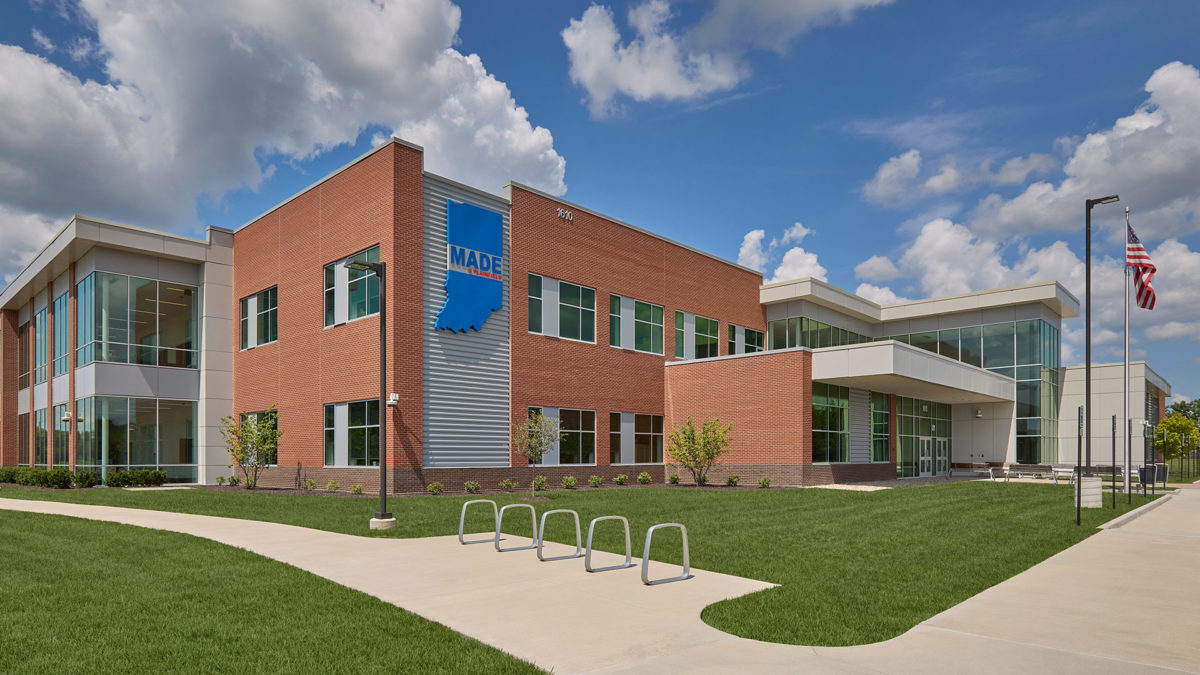
The vision for the Center was to provide a wide variety of educational learning and collaboration spaces, including specialty labs for robotics, PLC, warehousing, industrial maintenance, testing and health occupations. Multiple educational partners were recruited to share this facility to ensure a wide variety of program offerings. Participants include Vincennes University, Ivy Tech Community College, WorkOne, Hendricks College Network, and the Indiana Department of Homeland Security.
CSO led a collaborative process to program and design the facility. Visioning workshops for all stakeholders defined the important aspects of the projects. Then, during programming, looked globally across all space needs to identify opportunities for stakeholders to share key spaces to reduce the overall building square footage and increase space efficiency. Competitors, such as Ivy Tech and Vincennes University, had never shared a facility, so they were initially reluctant to consider sharing spaces. CSO’s expertise in building consensus helped all stakeholders successfully work through this challenging issue and prove out the benefits. Ultimately conference rooms, several classrooms, the community room, lounge/vending areas, collaboration/study areas, restrooms, and even the flex lab became shared spaces. The overall building design was key to gaining acceptance of this strategy.
The approach created a consistent design for the shared common spaces at the main entrance lobby and along the building’s main corridors. Stakeholder’s individual spaces were distributed along these splines and carefully positioned with enough separation to allow for individual identity.
The resulting design features a modern and inviting building exterior with large window walls surrounded by brick and metal wall panels. The two-story lobby at the main entrance is positioned at the building’s center to provide easy access for all tenants. The lobby is branded as MADE@Plainfield and features a reception desk, restrooms and dining area, offering direct views into both the flex lab and robotics lab for visitors. The main public corridors extend along the two window walls and incorporate the study and collaboration areas positioned along the outside walls. Natural light and exterior views make these inviting spaces for students. Natural light also floods into the adjacent classrooms spaces along the other side of these corridors though their interior windows. Large lab spaces are positioned behind the classrooms, allowing classrooms to have a direct connection. The project’s success comes from its unified appearance while at the same time meeting the individual needs of a diverse group of stakeholders.
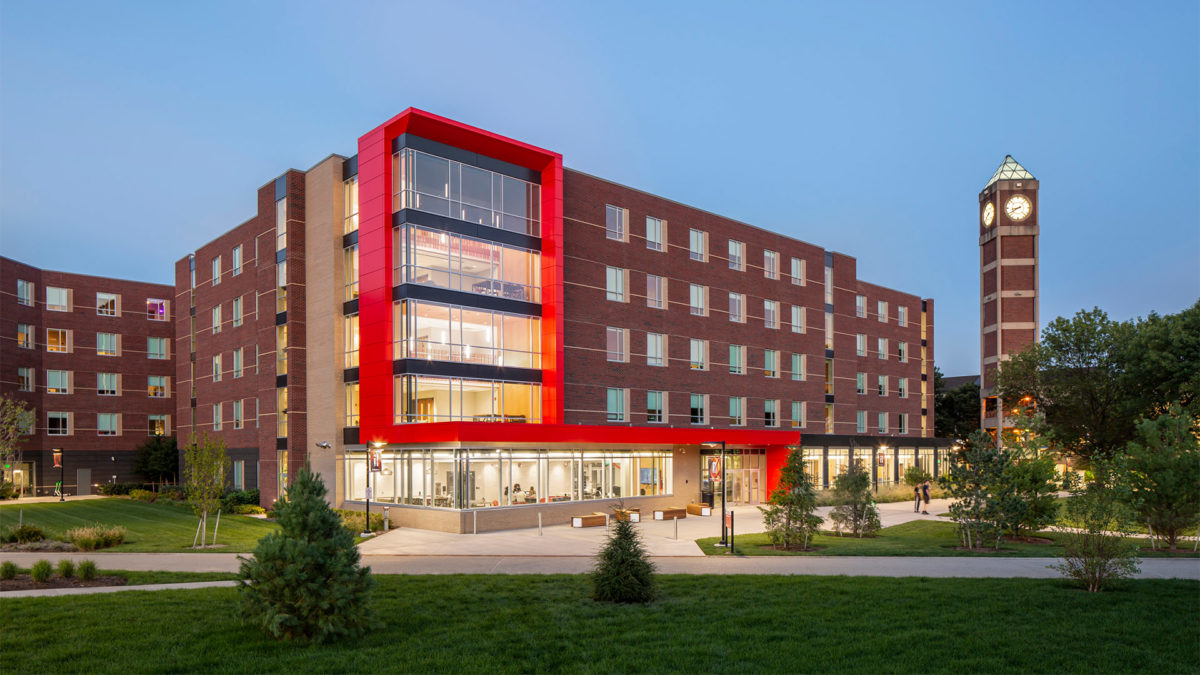
In order to maintain enough housing to meet the University’s current needs, the 5-story, 452-bed buildings were constructed in two phases. For the purpose of efficiency, floor plans for each phase are similar and include traditional-style double- and single-bedroom units arranged around a group of private-use bathrooms.
The buildings are designed to maximize the use of exterior spaces and to engage the students in active areas of living and learning. Amenities for each new facility will include a large multi-purpose room, collaboration spaces, a recreation/game room, a community kitchen, and multiple student lounges. As Design Architect on the project, CSO teamed with JRA Architects, of Louisville, as the architect of record for the project.
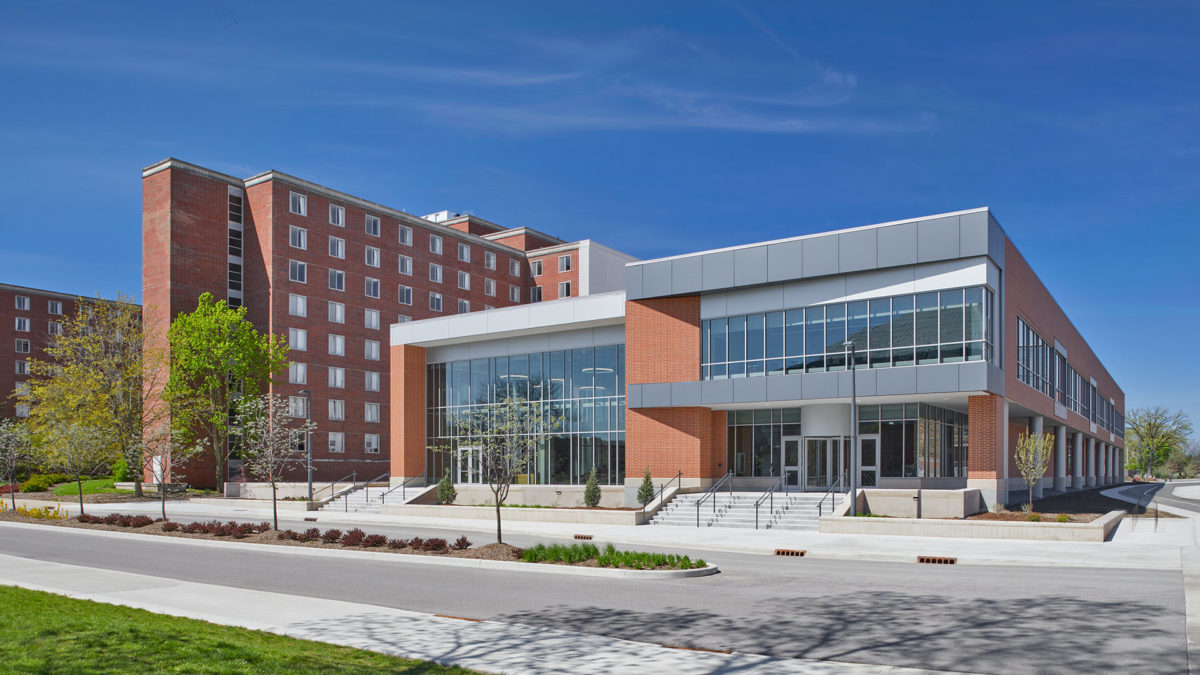
During the planning process, careful consideration was given to the facility’s location in relation to campus, and nearby residence halls. The design includes spaces for dining, collaboration, and studying. The facility will provide 685 seats in a variety of seating areas and offer Micro-Restaurant style dining with seven to nine different restaurant concepts. Centralized prep kitchen and dish washing areas, along with other back-of-house spaces, will support the dining operations. Dining and kitchen spaces are located on the main level.
In addition to dining, the facility will house the administrative offices for Dining & Food Services and Housing & Residence Life. These office facilities will be on a second level, with a designated entrance along McKinley Ave. This project was designed in collaboration with Hanbury.
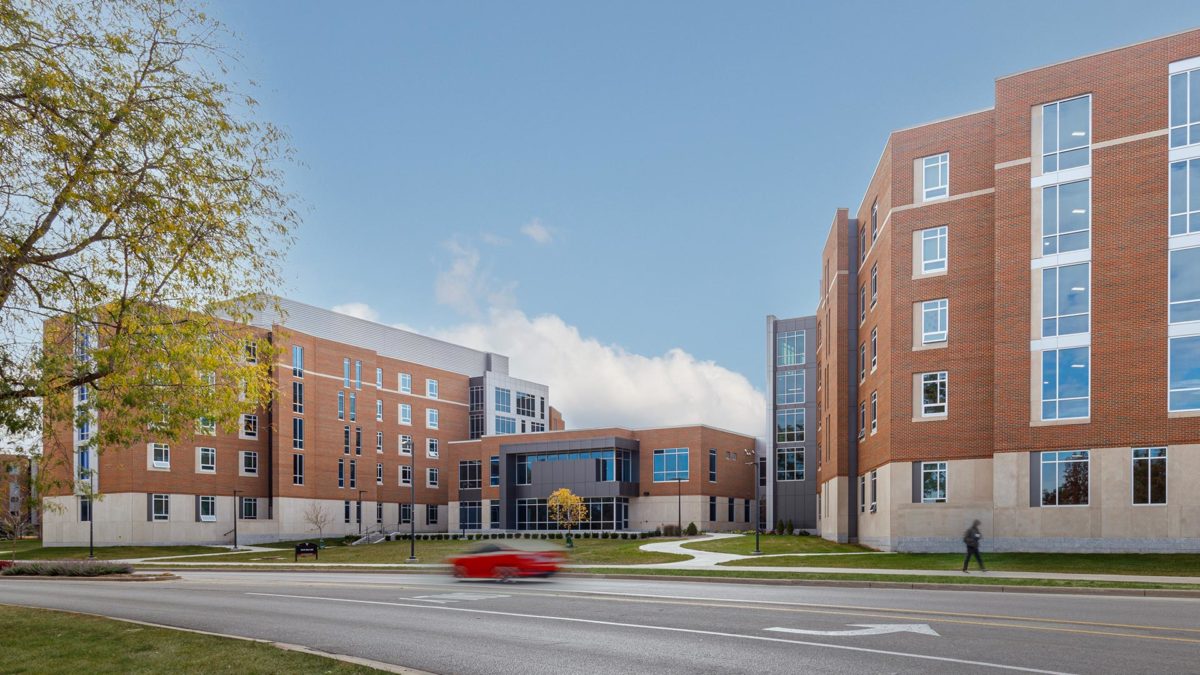
Located in the North Neighborhood Development of campus, the building is comprised of two residence towers, containing a community of 250 students per tower. Student rooms are mostly double configuration, with a mix of single and ADA compliant rooms per wing. Each floor contains approximately 27 rooms, including one Resident Assistant room. Bathroom facilities are arranged in four groups per typical floor, containing shared lavatory space and private toilet/shower compartments. Each residential floor of each tower has a dedicated lounge and kitchen space.
A central connector between each tower houses shared facilities such as laundry, group study, lounge, fitness center, mail, and administrative office spaces. Included in this two-story connector is a large multi-purpose room for the community, as well as designated Living-Learning maker spaces for Education. This connector acts as the main entry to the complex. This project was designed in collaboration with Hanbury.
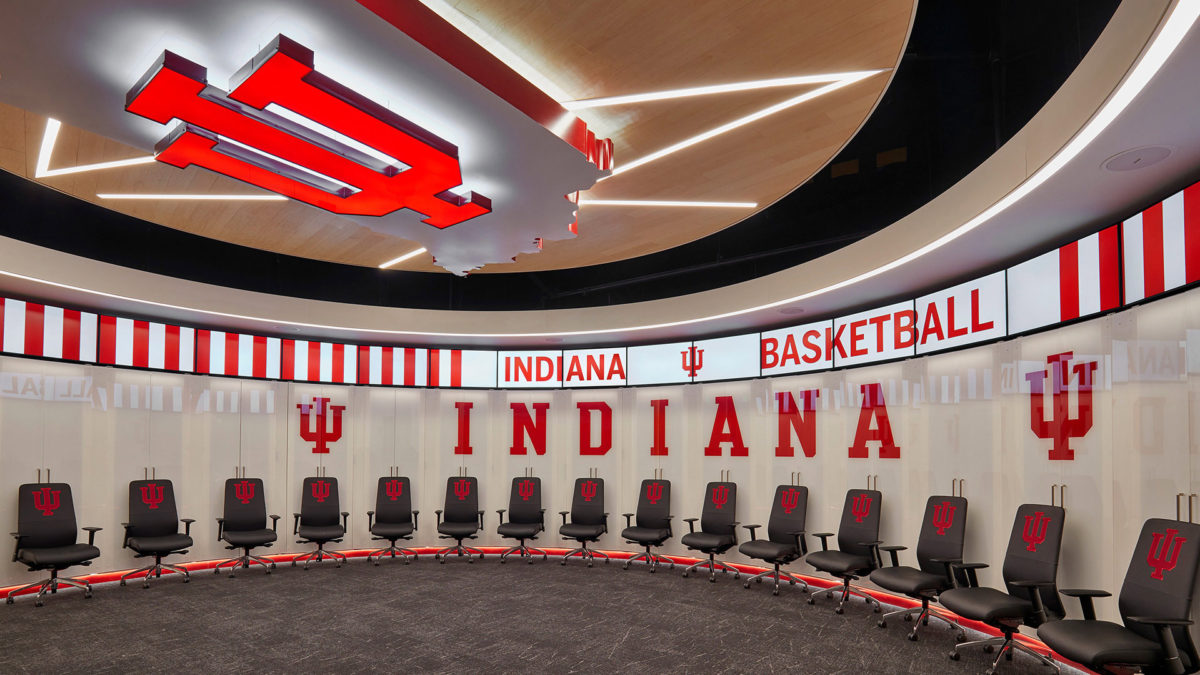
Upon the successful completion of the Simon Skjodt Assembly Hall addition project, the Indiana University Athletic Department discovered an opportunity to enhance an area of underutilized space within the building. The space located under the lower bowl was being utilized for storage, back of house restrooms, and various ancillary needs. With direct access to the basketball court, it made sense to reclaim this space as game day locker rooms, a players lounge, shower/restrooms, and coaching conference spaces – all of which did not previously exist within the facility.
After early discussions with the University it became apparent this space needed to be on par with many of the universities IU competes with for talent. The current coaching staff indicated that, while the space needed to be improved, there was also a strong desire to have it be modest. Above all requirements, the space needed to speak to the rich history of Indiana University Basketball with an eye to the future.
In order to meet the goals for the project, the design team incorporated wood, limestone, and back painted glass as the foundation of the finish palette. These finishes would serve as a clean backdrop to the iconic branding components found in the furnishings and implemented throughout the design. The overall composition created the motivational and energetic space required to attract new athletes, while reminding them of the honor involved in representing IU.
In a press release, Coach Archie Miller stated, “As a program we want our players to experience the best of the best, and as we took inventory on how we wanted to do things as a new staff, one of the things we really approached was a new area for our team and creating an environment that is cutting edge and second to none. I think that’s what we have been able to create here.”
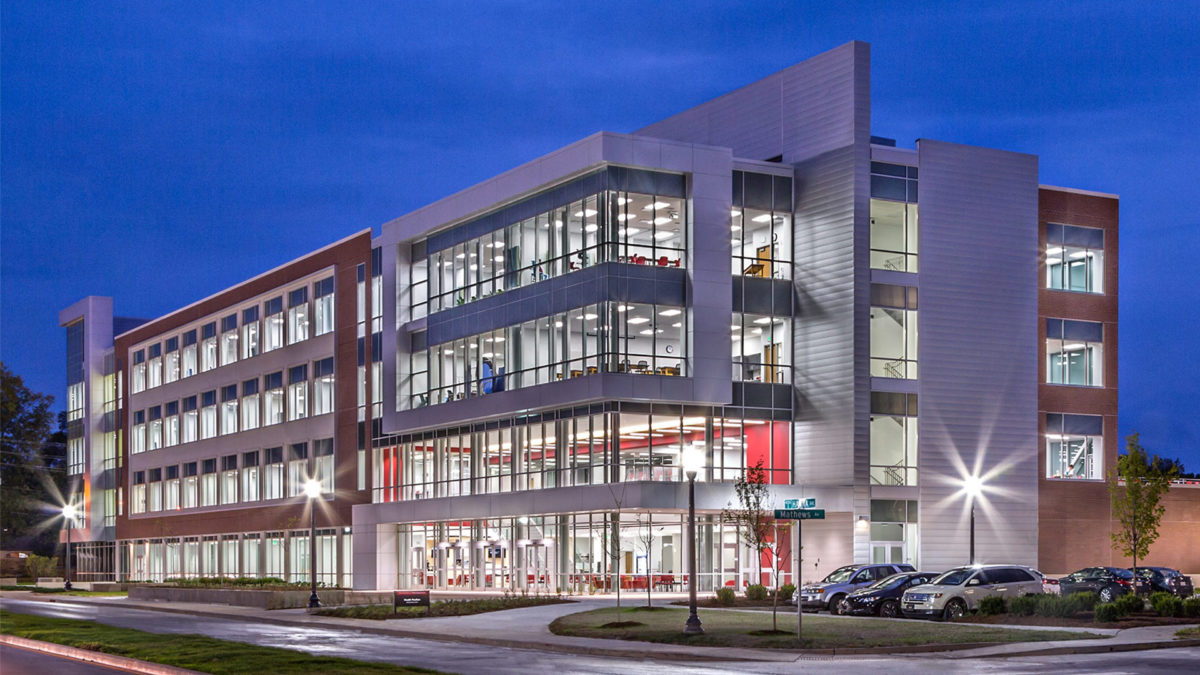
Part of the University’s efforts to economically revive the south side neighborhood and attract new students, the Health Sciences building provides a new gateway to campus and an integrated hub where faculty, students, and healthcare professionals can collaborate on education and research.
The new Health Sciences building is reflective of the University’s commitment to inspiring excellence by providing learning opportunities that respond in innovative ways to the needs of all students. The building design presents a transparent, flexible concept that allows for current and future needs of the programs housed within. The building’s prominent location creates an ideal venue for an outdoor seating and interaction area adjacent to the indoor café.
The building consolidates several departments into a collaborative and integrated learning environment that promotes intellectual and social interaction among students and faculty. Included in the design are teaching spaces, faculty areas, research labs, and wellness-related areas for the Physical Therapy, Occupational Therapy, Nursing, Kinesiology, and Psychology Programs.
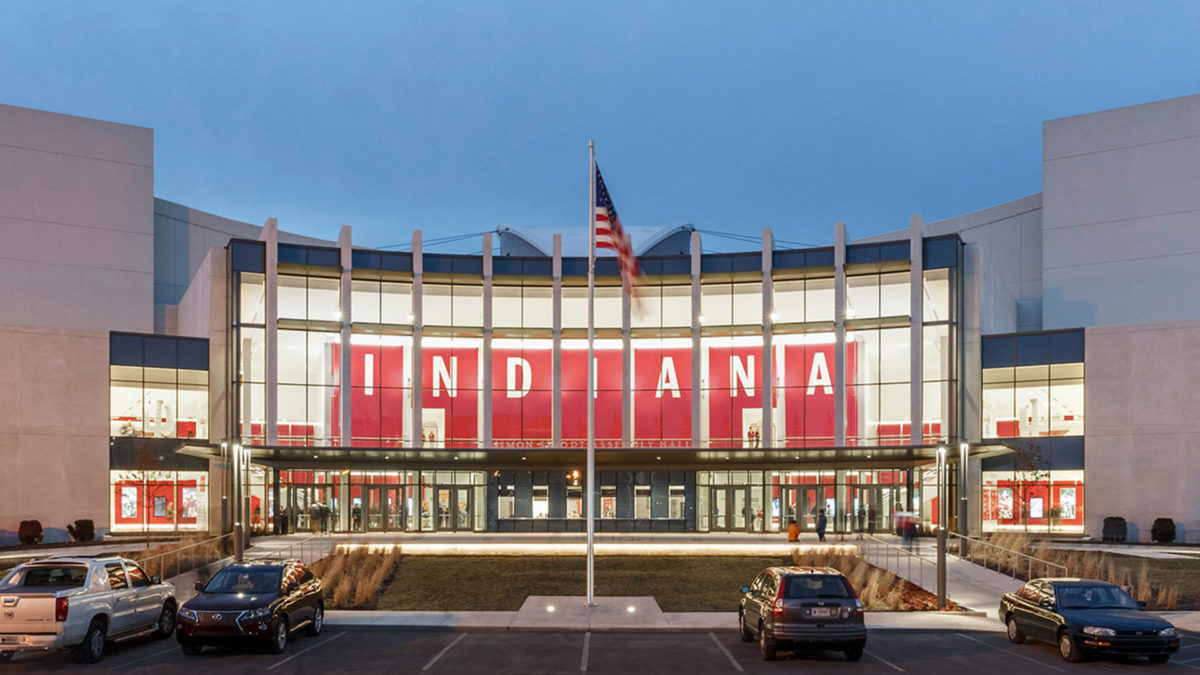
When Indiana University set out to improve the iconic Assembly Hall, they prioritized the preservation of the original aesthetic while challenging the design team to develop a bold, yet respectful expansion that closely aligned with the architectural character of the original structure. Contextual influences drove a design solution that integrated the new addition into the existing structure holistically with a reverent architectural expression that closely relates to the original.
A new atrium space allows views between the entry and main concourse. This is the center of the new space and features a reinvented version of Athlete’s Hall and a panoramic window allowing views into the arena. The new arrival area supports existing traditions while offering a space for new traditions, events, and ceremonies to take place. The new entry is conveniently located, and visible escalators create a clear and efficient means for moving spectators through the space into the arena. A new Box Seat Club offers an exceptional viewing experience of events. CSO collaborated with SmithGroup to complete this project.
CSO subsequently completed the Roberts Family Indiana Basketball Team Center and Mark Cuban Center for Sports Technology located within Assembly Hall.
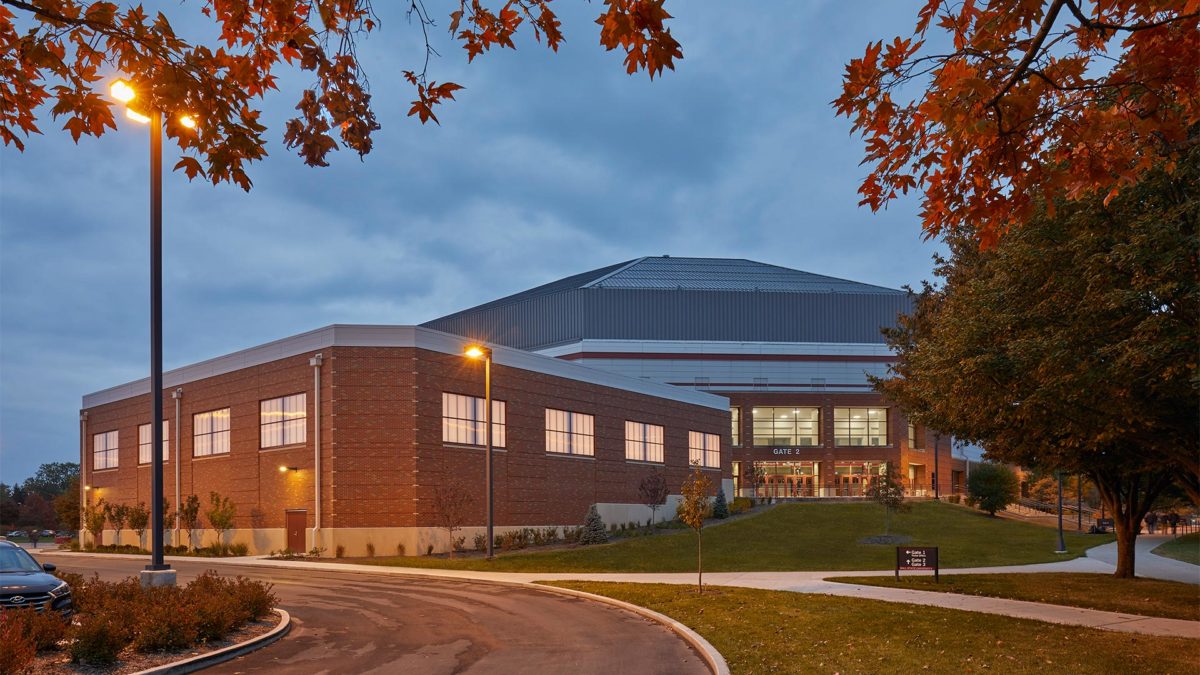
The Dr. Don Shondell Practice Center is a new building located adjacent to Worthen Arena which is home to the Ball State University Cardinal’s basketball and volleyball teams. The main area of the facility provides a new practice gymnasium and includes two, full-sized NCAA-compliant basketball and volleyball practice courts. The facility is accessible from Worthen Arena to provide access to existing locker and restroom facilities.
The connector between the two buildings has two levels. The main level provides an exterior entrance to the Practice Center with access to the courts and space for a team room with tiered seating, a training room, and courtside storage space. The second level aligns with Worthen Arena’s concourse level where there is access to two new meeting rooms that overlook the new practice courts.
The namesake of the facility, Dr. Don Shondell, established an impressive legacy as a men’s volleyball coach as well as the founder of the volleyball team at Ball State University.
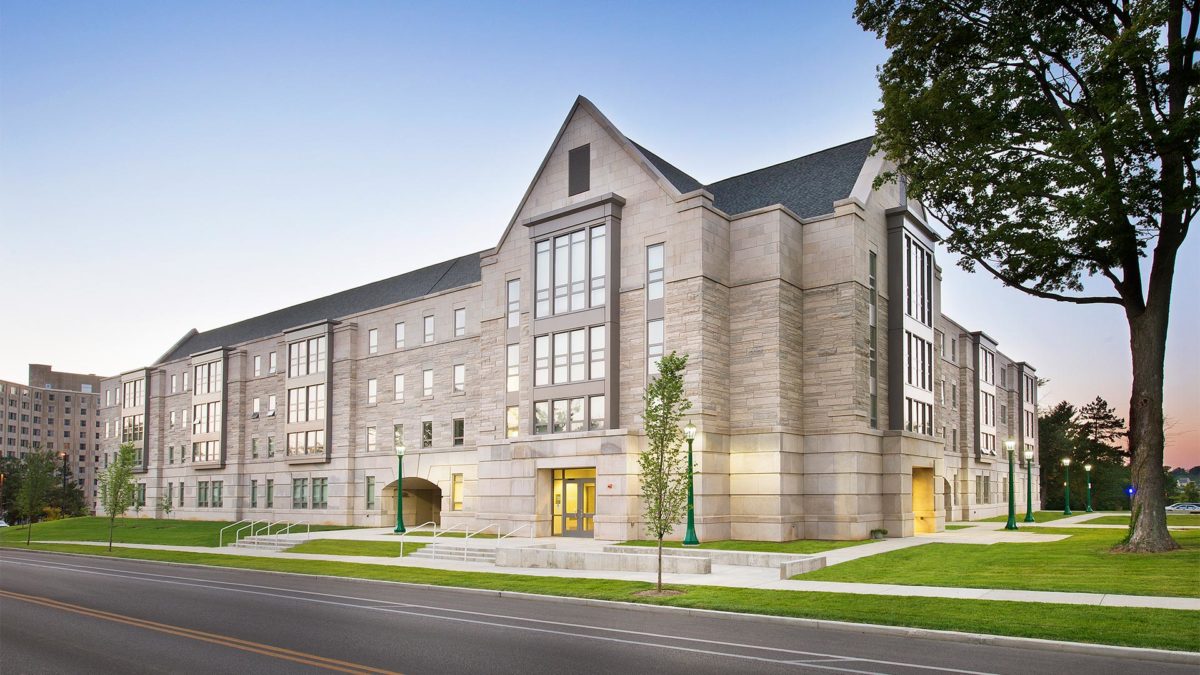
From the beginning of the project, CSO worked closely with the University and their Owner’s Representative to ensure that the project was completed on time and within budget. In order to achieve this, CSO proposed a fast-track approach utilizing multiple bid packages, which was an unfamiliar approach for the University.
Located in Indiana University’s Southeast Neighborhood, 3rd & Union provides students with a low-cost on-campus apartment option. The design blends traditional Gothic features with state-of-the-art amenities and sustainable design. The building features a limestone façade, steep roof with slate-look shingles, and a tunnel-like breezeway between its south and north wings.
The facility houses a combination of 102 one-bedroom and studio apartments designed to attract and retain upperclassmen and graduate students on campus. Each unit features a full kitchen, living area, bedroom, and private bathroom. The programming for the facility is rounded out with multipurpose spaces, a technology center, and laundry facilities that allow the building to facilitate a true living-learning community. In addition, the facility has two storage areas tucked into the exterior walls of the building providing complete shelter for bikes hanging on wall-mounted racks and a spacious recycling room conveniently located next to the exit.
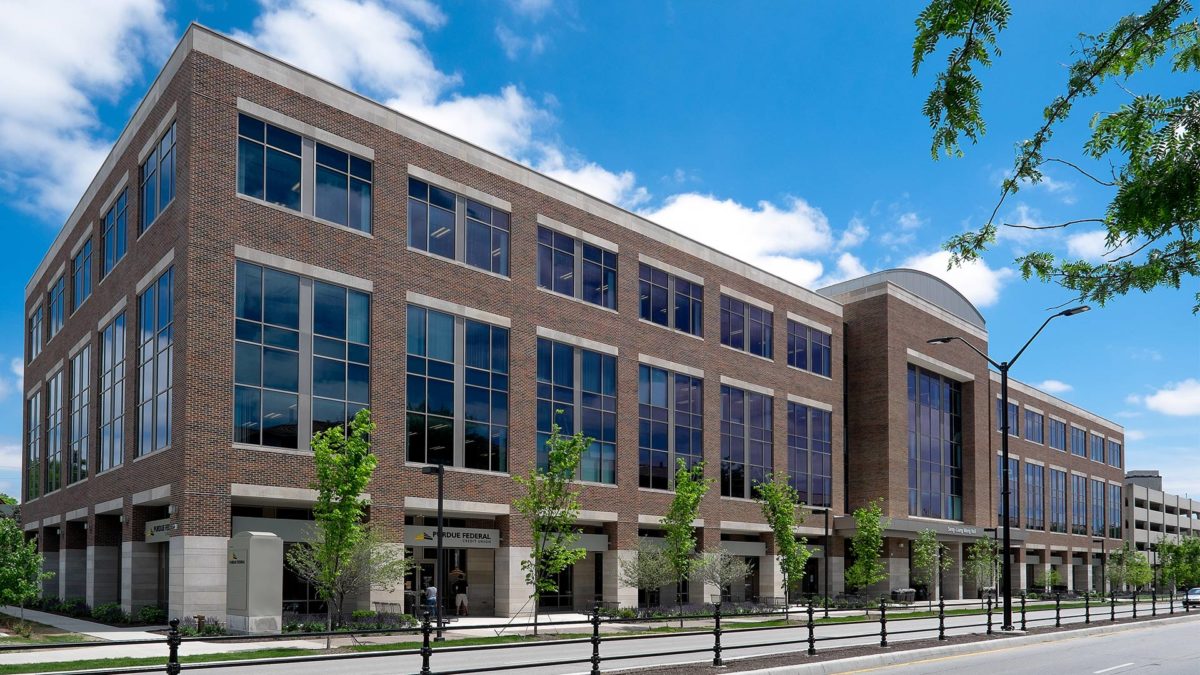
The 4-story, 147,000 square foot building is designed to house research and laboratory space for Purdue’s School of Electrical and Computer Engineering, as well as 22,000 square feet of commercially-leased retail space and 60,000 square feet of Class A office space. Its beautiful common areas include an open, light-filled 4-story atrium and indoor and outdoor gathering and seating areas.
The building received LEED New Construction Gold certification recognizing Wang Hall’s best-in-class “green” building strategies and practices. The building was completed on a sustainable project site and is located in a community setting within existing residential and commercial infrastructure. In addition, the building and site were designed to minimize the impact of urban heat islands on neighboring developments and habitats. The design is mindful of both water efficiency and energy efficiency, and was designed with low-flow and high-efficiency flush and flow fixtures to reduce potable water use within the building.
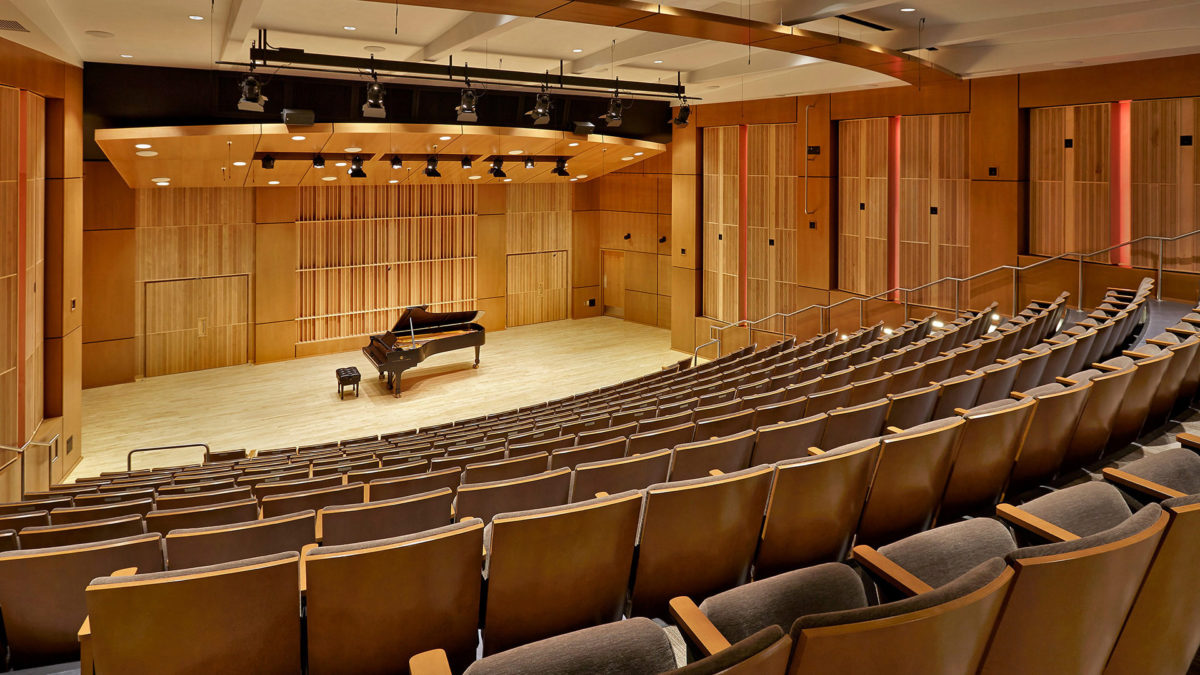
From the onset of this performance hall project, the design team was challenged to think outside of the box to craft a solution that would meet the demanding requirements of the Ernestine M. Raclin School of Music students and faculty within a very tight budget and time frame. The conversion of an existing lecture hall and its adjacent spaces into a state-of-the-art recital hall is the culmination of the Joshi family’s vision to provide young musicians and singers excellent educational and career development opportunities at IUSB. Indiana University turned to CSO for their performing arts expertise after the original design team was unable to provide a solution within budget. CSO’s design incorporates an electronic architectural sound system that provides optimal acoustical characteristics within the confines of the existing space without major, costly physical modifications.
Each element of the design supplements the integrated sound system, in order to achieve a harmonious balance of sound and “sparkle”. The formerly carpeted walls are now clad in rich wood paneling and acoustic diffusion systems which add physical and acoustical warmth to the space. Deep red tapestry has been integrated into the side walls to add an air of sophistication to the space. All of the elements work together and create an experience for every patron, allowing them to be completely enveloped by the art being performed on stage. The performance hall provides a world class venue for chamber music, soloist, and small ensemble performances in addition to providing the use of state-of-the-art recording equipment for students and faculty.
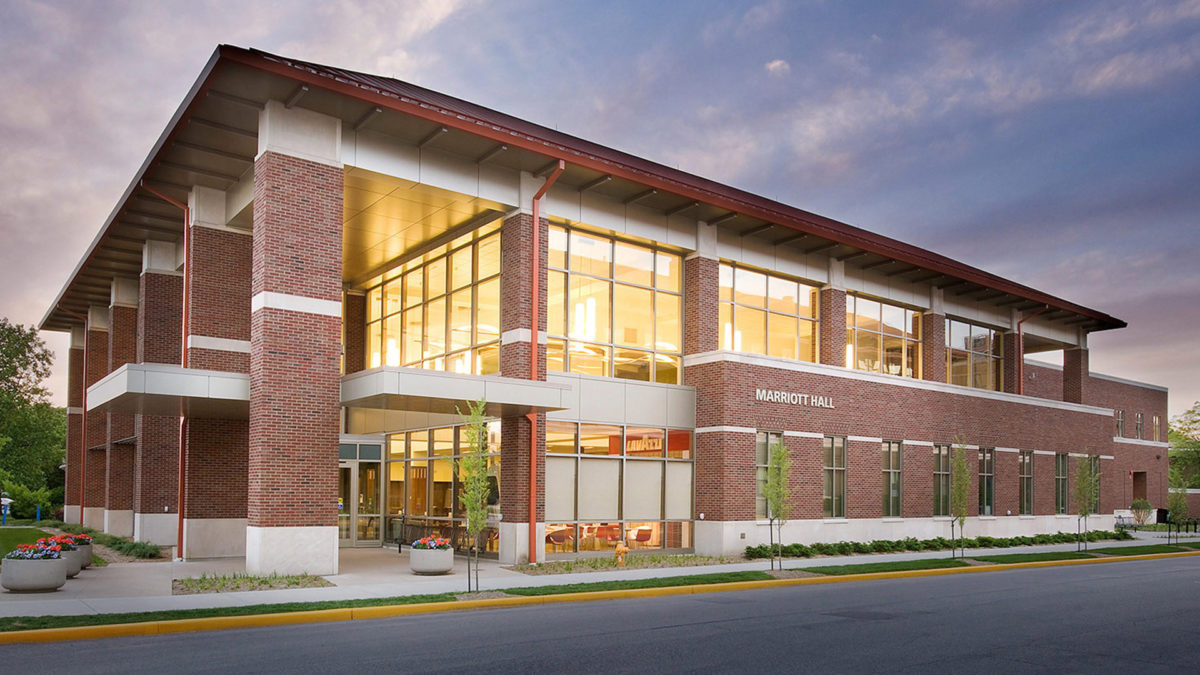
The facility is a teaching facility as well as a student dining venue. The design of Marriott Hall recalls the “quintessential Purdue style” of dark red brick and tile roof found on adjacent academic halls, while providing a more open and inviting transparent façade on State Street. The interior features a two-story dining space with a coffee bar and two student-operated restaurants: The John Purdue Room, a fine-dining restaurant in which students prepare and serve the food and manage the kitchen and dining room, and The Boiler Bistro, a quick-service restaurant where the food is cooked to order. These spaces are supported by the Teaching Kitchen, which functions as a lab as well as the main kitchen preparation area for the facility. A 95-seat demonstration hall consists of a lecture room with a kitchen that is used to teach cooking classes.
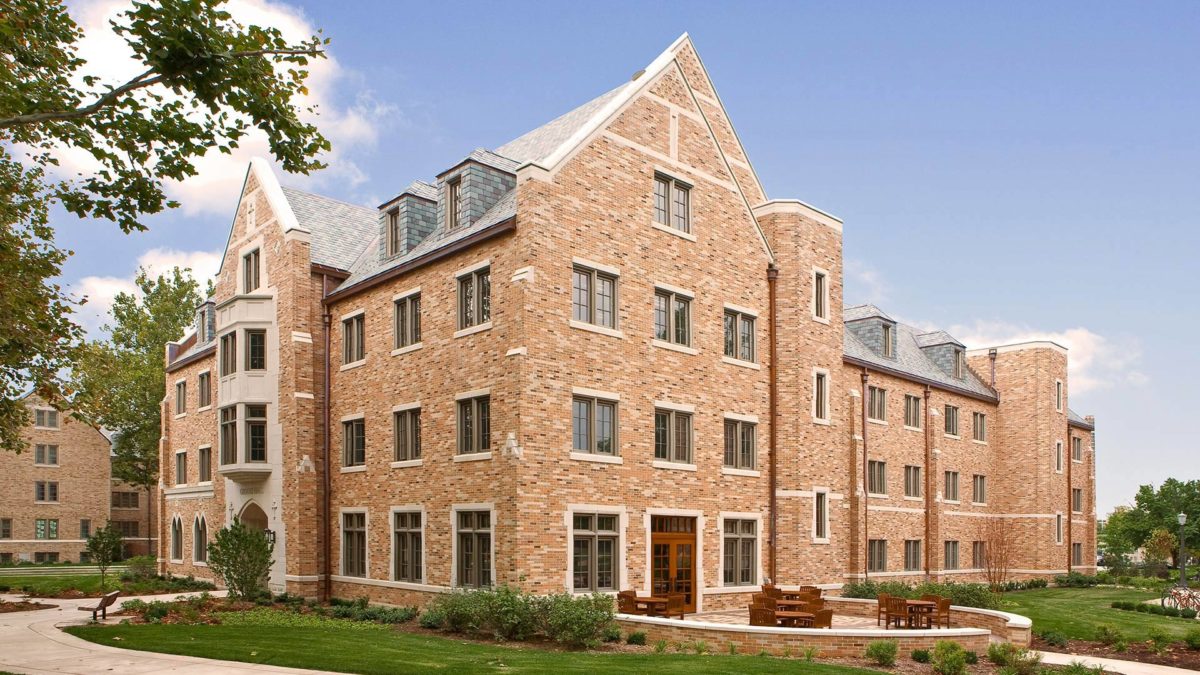
The building features the University’s traditional blend of brick colors with light colored cast stone accents, copper gutters and downspouts, and a slate roof. The façade is punctuated with regularly spaced operable windows. The detailed profile of these windows exactly match the historic wood windows installed in the two buildings adjacent to the project, which were built in the 1940’s. The Geddes windows, however, reinterpret the window design in long lasting, energy efficient, and maintenance free anodized aluminum frames with high performance glazing.
The interior is distinctly arts and crafts inspired. Warm yellows, earthy reds, and muted deep green colors are used throughout the building giving it a cozy earthy character. Wood wainscoting used heavily in the public spaces adds to the building’s inviting nature and historic feel. Informal gathering spaces of various sizes are found throughout the building. Of particular note is the student library, found on the first floor, which features a fireplace centered along the north wall flanked by traditional built-in bookcases and classic arts and crafts furniture. Two of the other focal points on the first floor are the chapel and coffee house, located just off the building’s main entrance.
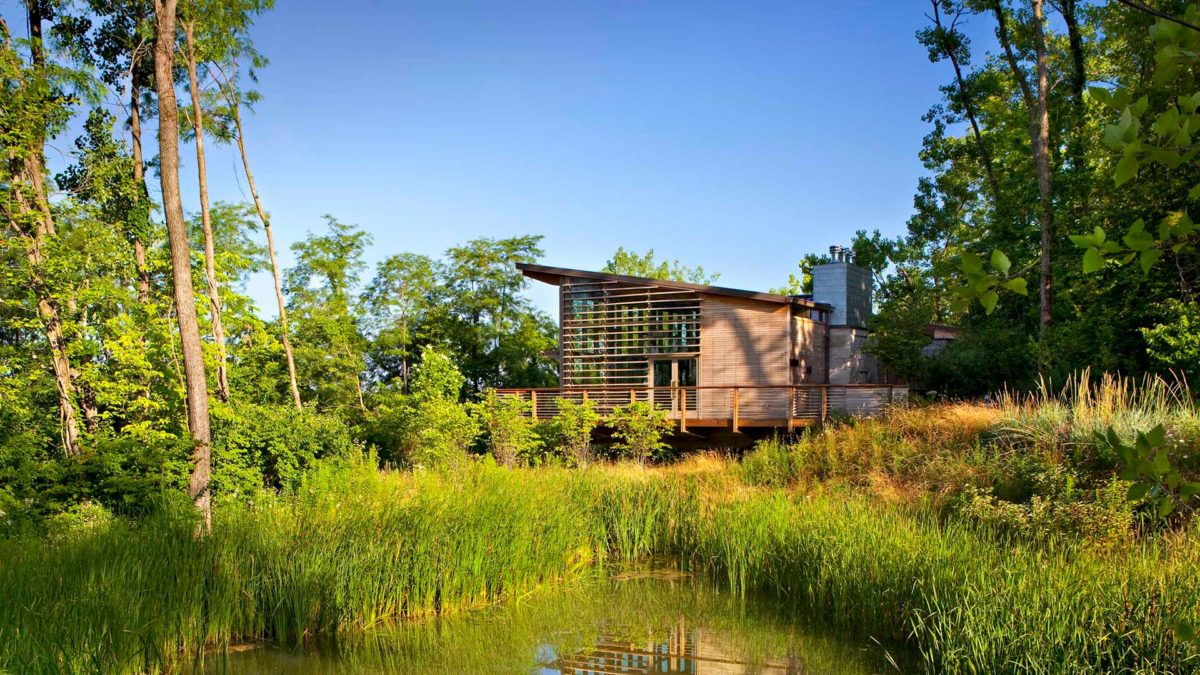
The James and Susan Bartlett Center for Reflection was conceived as a quiet, contemplative place located in the DePauw University Nature Park. The University envisioned a unique place for reflection on values and thoughtful examination of life.
The Center is anchored by a glass-walled gathering room featuring a towering limestone fireplace that serves as a backdrop to group discussions, lectures, sermons, and events. The building also includes a theological library and extensive outdoor deck areas in order to enjoy the surrounding environment.
The small structure was designed sustainably to minimize its impact on the environment and its immediate environs. The building was constructed with natural, regional, and recycled materials. The site and adjacent habitat were restored with native Indiana plants and incorporate a natural rainwater treatment pond. The interior environments were designed to maximize natural light, views, human comfort, and controllability. CSO completed this project in conjunction with Lake|Flato Architects.
